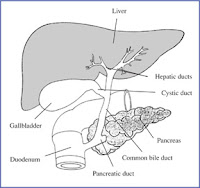Primary sclerosing cholangitis (PSC) is a disease that inflames, scars, and blocks bile ducts inside and outside the liver. The bile ducts are small tubes that carry bile out of the liver to the gallbladder and the small intestine. Bile is a liquid formed by the liver, which when release in the small helps break down fat in food.
Bile is a liquid formed by the liver, which when release in the small helps break down fat in food.
In PSC, the bile ducts become inflamed, which can lead to scar formation and narrowing of the ducts over time. Continuous scarring of the ducts can cause them to become totally blocked. Total blockage of the bile ducts cause build up bile in the liver, which can damage liver cells. The scar tissue can spread throughout the liver, causing cirrhosis and liver failure.
PSC occurs more often in adults but the disease may also affect children. Risk of developing the disease increases when a family member has PSC. The condition is more common in men than in women and the average age at diagnosis is 40.
Causes
The cause of primary sclerosing cholangitis is not fully known. However, experts believe that genes, problems with the immune system, bacteria, and viruses may play roles in the development of the disease.
Also, PSC is linked to inflammatory bowel disease (IBD). The link between PSC and IBD, however, is not fully inderstood. About three out of four people with PSC have ulcerative colitis—a type of IBD.
Symptoms
PSC develops and progresses slowly, making a person with the disease symptoms-free for many years. When symptoms do appear, the person may experience itching, fatigue, and yellowing of the skin and whites of the eyes. Fever and chills may occur when the bile ducts are infected.
Signs and symptoms of PSC may resemble signs of other conditions or health problems, a consultation with your doctor is necessary.
Complications:
Various complications may result from PSC, including
deficiencies of vitamins A, D, E, and K
infections of the bile ducts
cirrhosis—extensive scarring of the liver
liver failure
bile duct cancer
[ 1 ] [ 2 ]
Image Credit: National Institute of Diabetes and Digestive and Kidney Diseases (NIDDK)
Page Last Revised: August 2, 2012
[Top of Page]
 Bile is a liquid formed by the liver, which when release in the small helps break down fat in food.
Bile is a liquid formed by the liver, which when release in the small helps break down fat in food.In PSC, the bile ducts become inflamed, which can lead to scar formation and narrowing of the ducts over time. Continuous scarring of the ducts can cause them to become totally blocked. Total blockage of the bile ducts cause build up bile in the liver, which can damage liver cells. The scar tissue can spread throughout the liver, causing cirrhosis and liver failure.
PSC occurs more often in adults but the disease may also affect children. Risk of developing the disease increases when a family member has PSC. The condition is more common in men than in women and the average age at diagnosis is 40.
Causes
The cause of primary sclerosing cholangitis is not fully known. However, experts believe that genes, problems with the immune system, bacteria, and viruses may play roles in the development of the disease.
Also, PSC is linked to inflammatory bowel disease (IBD). The link between PSC and IBD, however, is not fully inderstood. About three out of four people with PSC have ulcerative colitis—a type of IBD.
Symptoms
PSC develops and progresses slowly, making a person with the disease symptoms-free for many years. When symptoms do appear, the person may experience itching, fatigue, and yellowing of the skin and whites of the eyes. Fever and chills may occur when the bile ducts are infected.
Signs and symptoms of PSC may resemble signs of other conditions or health problems, a consultation with your doctor is necessary.
Complications:
Various complications may result from PSC, including
deficiencies of vitamins A, D, E, and K
infections of the bile ducts
cirrhosis—extensive scarring of the liver
liver failure
bile duct cancer
Image Credit: National Institute of Diabetes and Digestive and Kidney Diseases (NIDDK)
Page Last Revised: August 2, 2012
[Top of Page]
